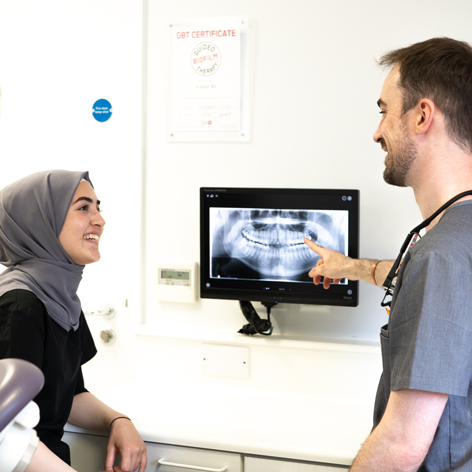Your dental consultation explained

When you visit us for a dental consultation, in addition to talking to you about all your dental experiences and concerns, we'll perform a detailed examination of your whole mouth. This is nothing to be frightened of, just a very thorough look around, so we can get an accurate picture of your oral health.
Some of the specific things we look for or check are:-
- Assess your overall health
- Evaluate your risk of tooth decay
- Examine for root caries
- Examine for gum disease (Periodontal disease)
- Examine your jaw and bite for problems
- Take radiographs (X-rays) or if needed carry out other diagnostic procedures
- Assess your need for restoration or tooth replacement, such as direct restorations (fillings, root canal) or indirect restorations (crowns, veneers, inlays) and solutions for missing teeth (dentures, bridges or implants)
- Oral (mouth) cancer check
- Evaluate your fluoride exposure (through hygiene products and diet)

HENRY “A lot of people, knowing they're about to go to their dental appointment, brush like mad just before, like brushing really hard is going to make up for months of doing it a bit half-heartedly. Believe me, it won't. It doesn't help and we always know you’ve done it. You will have grazed your gums, and sometimes the gums are really pouring with blood because you've attacked them so hard. It's just not a true representation of what your teeth are like day-to-day.
I'd really like to see people who haven't done that. Yes, you need to brush your teeth before your appointment, but clean in the normal way, like you would every night before bed. So no pneumatic-drill brushing just before your appointment please.”
New private patient consultation
How is this different to a routine examination?
If you are visiting Clinic 95 for the first time, your initial consultation will be a little longer than a routine examination, as your dentist will need to fully discuss with you the full range of your health and oral health matters, so that they can gain a complete picture of your dental needs.
Routine Dental Health Consultation
We'll always start by getting you to complete our unique 17 point dental health checklist and medical history form. By doing this, your dentist can then easily and accurately check any differences you report in your oral or overall health.
But the checklist is only a guideline for us. Sometimes there will be areas that don't need much or any attention and others which need quite a concentration of action and advice from the dentist. We'll always fully discuss with you which areas we feel need to be addressed and of course will always talk you through the reasons behind all the decisions we make and conclusions we reach. So although we call it a routine dental health consultation, no two consultations that you'll have with us will be the same – every visit will probably be slightly different.
Assess your overall health as well as your oral health
Did you know that there are many medical conditions (including some cancers) that can be spotted by a dentist? Your oral health is often an indication of your overall health, so here at Clinic 95 we always perform finely detailed examinations so that we can give you as much information about your health and oral health as possible.
Evaluate of your risk of tooth decay
Lots of things can cause tooth decay. Some, like a diet that's high in sugar or acid (like the kind you find in fruit juice), can be remedied by changes to your lifestyle. Others may not be so obvious. For example, there are some medications that can cause a dry mouth, which can then cause cavities since good saliva flow helps prevent tooth decay.
Therefore your dentist will carry out a full assessment of your risk of cavities and will provide advice on how you can prevent tooth decay.

Did you know..?
A quick remedy for a dry mouth is to think about lemons. Imagine lemons being cut in front of you and think about the juice running out of them. Do this vividly enough, and your mouth will pour with saliva.
Examine for root caries
Root caries are a lesion on the root surface of a tooth, often close to or below the gingival margin. To identify these, your dentist will often use a radiograph to help diagnosis, examining for early signs of a matte appearance and a softening of the root surface.
Why it is important to check for root caries?
Because as patients grow older their gums recede and root surfaces are exposed, making them more susceptible.
Therefore, the elderly are usually more vulnerable to root caries. Also, taking certain medications that reduce saliva flow and cause a dry mouth can contribute to root caries. And any caries-prone patient having gingival recession can develop root caries.
Treatment of root caries generally requires a restoration or crown and an adaptation to your oral hygiene regime possibly using a toothpaste with higher fluoride content.
Examine for gum disease (Periodontal disease)
Gum disease is incredibly common, and if it isn't spotted early, can lead to a whole host of oral and overall health issues. So getting not just your teeth, but your gums thoroughly examined by the dentist is a simple way to look after your health.
Nearly 80% of people suffer from a mild form of gum disease (gingivitis) that can lead to bleeding gums, where often the plaque will harden on the teeth forming a calcified deposit calculus or 'tartar'.

Did you know..?
Sara "Once calculus and tartar have formed, they're harder than bone, and just keeps forming on top of themselves, until you get it professionally removed."
10-20% of people are genetically more susceptible to the effects of plaque and as a result, permanent irreversible damage may be caused to the attachment of the gum to the tooth (periodontitis). This in turn can result in the formation of gaps between the gums and teeth (pockets) in which more plaque and bacteria can collect. As the pockets deepen, the plaque becomes more inaccessible to cleaning, more extensive and more toxic. This leads to increased damage to the supporting bone around the roots of the teeth, which if left untreated can result in the loss of the tooth and many other health problems.
For instance,
did you know that there is compelling evidence to suggest that gum cells
release toxins which can enter the blood stream, and go anywhere the
blood flows. There is also a strong link between gum disease and an
increased risk of heart disease. As if that’s not compelling enough, we
can add a little bonus, in that the examination for gum disease is
fairly simple and isn't particularly painful.
What the dentists will do:
The gum tissue will be gently probed by inserting an instrument into the pocket areas of your gums. It is a tiny instrument that has a rounded (not sharp) end. Only light pressure is necessary and it's unlikely that you'll find this uncomfortable.
The dentist will then record a
score for each area using a chart, which will then indicate whether you
may need to be referred to one of our hygienists for advice or
treatment, or to our clinician with a special interest in Periodontitis Sara Vargova for
assessment.
Examine your jaw and bite for problems
Does your jaw click or pop? Cause you any discomfort when you open your mouth or when you chew? Does it ever lock?
At your routine dental examination, your dentist will check for these by examining your jaw and surrounding muscles. If you report (or the dentist detects) any of these problems, you may have a condition known as Temporomandibular disorder (TMD) sometimes referred to as TMJ (Temporomandibular joint), although that’s the name of the joint itself.
We can help treat these and relieve any discomfort you have been experiencing, and have two dentists who can specifically advise you, Harris Smeyatsky and Adrian Jones. For more information, see our dedicated page on jaw problems.
Take radiographs (X-rays) or if needed carry out other diagnostic procedures
X-rays aren't always needed during your routine dental exam. Your dentist may be able to fully examine your whole mouth without the need for x-rays. However, if you do need them, here are some details about when they might be required and what’s involved.

Did you know that the amount of radiation you receive via x-rays is cumulative over your lifetime?
Even with recent advancements in safety, the total amount of radiation you have been exposed to increases with every x-ray and never diminishes.
There are two main types of x-rays for the oral area, namely:
Intraoral – the x-ray film is inside the mouth
Extraoral – the x-ray film is outside the mouth
Which one is used is dependent on exactly what the dentist needs to see.
Intraoral x-rays are used to reveal decay between teeth, the presence or effects of gum disease or infections, the stability of restorations like crowns and bridges and also to check that there are no problems around or underneath your fillings.
Extraoral x-rays taken from outside the mouth to give a more complete image of your teeth, gums and all the associated structures, and are used to diagnose problems with the whole jaw (orthodontics and endodontics) and to also check the success of surgery such as implants.
Clinic 95 use the Carestream 3D Extraoral imaging machine to take Extraoral radiographs.
X-rays can sometimes also be useful for kids, helping us to determine how a child's permanent (adult) teeth are likely to position, and predict any issues with the appearance of wisdom teeth.
But as we've said, you don’t always need an x-ray, and because of the cumulative effect of radiation we don't x-ray your mouth unless we feel it's absolutely necessary. That said, the information we get from x-rays can help us to predict and treat a huge range of dental and oral problems.
Assess your need for restoration or tooth replacement
Do you need simple fillings, more complex restorations or tooth replacement?
During
your dental examination your dentist will carefully assess your need
for any type of restoration, from a simple, tiny filling right up to an
entire tooth removed and replaced. It forms an integral part of your
examination and the dentist will fully discuss their findings with you.
Often, for teeth that need some form of restoration, there is more than
one option for treatment, so we will always chat through everything you
need to make a decision about what type is right for you.
Direct Restorations
Direct restorations include fillings and root canal treatment, where the added material, be it amalgam, dental composites, or glass ionomer cement, is applied and shaped by the dentist.
To determine if you require any of these types of restoration, the dentist will thoroughly examine the inside of your mouth, including all teeth and their surrounding gums.
The main part of the examination is visual, with the dentist looking for tell-tale signs of tooth decay. To do this, they will look at your teeth from every angle they can, and will use light to shine onto and sometimes through the teeth to assess their health. The dentist may also gently use a probe to assess the teeth or the area immediately around them. And of course, in order to clearly see the areas between the teeth (which can be hard to see), x-rays may be necessary.
Our patients usually find that the routine examination for identifying any decay in their teeth is a comfortable one.
Indirect Restorations
In some cases, our examinations identify teeth that require more intervention than a straightforward filling can provide. In this case, we may recommend indirect restorations such as inlays, crowns, bridges and veneers. These are created to order in a laboratory and then secured in your mouth by your dentist. And indirect restorations can also cover gaps left by missing teeth, again made specifically to order for you in a lab. These are implants, and they form such an important part of the work that we carry out here, we have an entirely separate website for you thats solely about our implantologist.
Oral (mouth) cancer check
Cases of oral cancer are on the rise. So, as part of your routine dental examination here at Clinic 95, we will fully check your mouth for any signs of oral cancer. This is nothing to be alarmed about.
New incidences of oral cancer are currently being diagnosed at roughly 17 new cases per day in the UK – a tiny proportion of all the many thousands of dental health checks that are carried out daily.
And the check itself is very simple, very quick and totally painless, and involves the dentist simply carrying out a mainly visual examination.
The dentist will check your neck, using their fingers to gently feel around the lymph node area, and then the rest of the examination is purely visual. The dentist will examine your lips, gums, cheeks, tongue and roof of your mouth – basically all around the inside and outside of your mouth and throat.
The dentist will be able to clearly see if there are any areas of concern. Most likely, there won't be, and you will be told this immediately. No further test is needed.
In the rare cases where the dentist sees something that they feel may need further exploration, they will refer you to consultant at a local hospital for a more detailed examination.
The good news is that the rates of survival of mouth cancers is very good, if caught at an early stage.
Evaluate your fluoride exposure
And finally, by means of an assessment of your daily oral hygiene processes and a chat about your diet, we will determine your likely fluoride exposure.
All of this build to a truly thorough oral health assessment and the advice and guidance of our team will help you make informed decisions about what (if any) treatment plan you require to get the most from your smile.
Costs
All our pricing details are on our treatment costs page.
Glossary:
Decay: Destruction of tooth structure caused by toxins produced by bacteria. Decay is caused by a combination of factors, including bacteria in your mouth, frequent snacking on sugary foods or drinks, and not cleaning your teeth well.
Radiographs: An image produced on a radiosensitive surface such as photographic film by radiation rather than visible light. Also known as an X-Ray.
Veneers: Thin shells of porcelain bonded to the front of the teeth to improve appearance. These can be used to fix chipped, stained, misaligned, worn-down or abnormally spaced teeth.
Flouride exposure: The amount of fluoride ingested or applied to your teeth throughout your life.
Root caries: The tooth is in two areas, the crown which is the section in the mouth and the roots normally beneath the gum and in the bone. In time and with age the root becomes exposed and this is more susceptible to decay and results in root caries.
Root canal (aka Endodontic Therapy): Cleaning out and shaping and then filling the area within the tooth structure that was occupied by the pulp, known as the root canal
Bridges: A fixed dental restoration used to replace a missing tooth or teeth by joining an artificial tooth permanently to adjacent teeth or implants.
Periodontal disease: Periodontitis is a gum infection that damages the gums and destroys the bone that supports your teeth. Periodontitis can cause tooth loss, and increase the risk of heart attack or stroke and other serious health problems.
Crowns: A crown is a tooth-shaped cover placed over a tooth that is badly damaged or decayed. A crown is made to look like the tooth. Many people call it a cap. A crown is also the name for the very top surface of a tooth.
Implant: An artificial tooth that is anchored in the gums or jawbone to replace a missing tooth.


